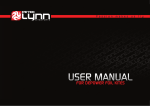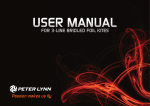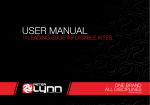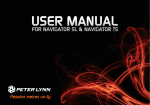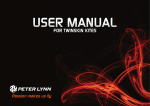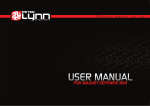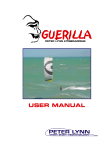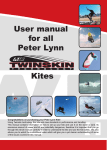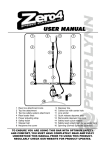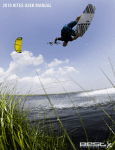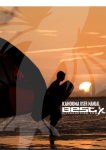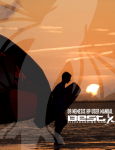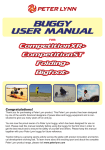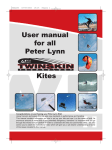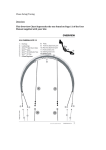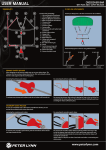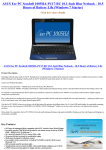Download Untitled
Transcript
WELCOME Thank you for buying this Peter Lynn product, and welcome to the World of Peter Lynn, a world of wind driven excitement, where people passionately pursue their dreams whether that’s freeriding at a local beach or enjoying the virgin snow on a back country adventure. Peter Lynn is there to help them pursue their dreams, Peter Lynn is here to help you pursue your dream, making you achieve your ultimate challenge. Are you ready? Peter Lynn has been there taking challenges from the early days of the sport. Challenges to develop breakthrough ideas, make better products, improve performance and quality in all aspects of those products. We have the right kites for all kite disciplines, for any terrain and for all conditions. All this is realized by a passionate crew of kite sports enthusiasts and we invite you to join us. It’s that passion that makes us fly. Before any attempt to use this product, please ensure you pay full and careful attention to the contents of this manual. While traction kiting is an exciting and fun sport, it can be highly dangerous, especially if not all the necessary safety precautions are taken. So please make sure you learn this great sport in a safe way. Only then will you progress quickly and enjoy this beautiful sport to the max. Enjoy! Safety instructions CAUTION: Kite powered sports can be very dangerous and physically demanding. The user of this product should understand that participating in kite powered sports may involve serious injury or death and agrees to observe the safety precautions listed below. Safe location and weather conditions: • Stay away from power lines, roads, airfields, railway lines, trees and buildings. • Never launch your kite in crowded areas. Do not fly your kite over bystanders. • Make sure there is a ‘clear’ downwind area at least three times the distance of your flying line length. • Never fly kites or use this product in thunderstorms, lightning or gusty/stormy winds. • Never fly a kite or use this product with wind forces so strong that you are unable to maintain full control of your kite and its power at all times. • Do not fly a kite or use this product when wind conditions are likely to change dramatically. • Stop kiting immediately when a (thunder)storm is approaching. • Make sure you are familiar with the location and local customs and laws before attempting any kind of kite sports. Safe traction kiting: • A traction kite is not a toy and should not be flown by inexperienced persons and certainly not by children. • Learn to fly kites by starting in light winds with a small sized kite. • Never use any type of kite or this product for paragliding, parachuting or base jumping. • Never use any type of kite or this product for jumping off high places like hills or cliffs • Never use any type of kite or this product for any manlifting activity. • Always wear fully protective gear. Safety issues when using this product: • Prior to every use of this product, fully check your equipment for any signs of wear and tear. Replace parts immediately where needed. • Prior to every use of this product, check if your safety releases are still working properly and you are aware how to use it. In case the safety release does not work as it should, do not use this product and replace parts where needed. • Only use this product for power kiting, buggy riding, landboarding and snowkiting. • Only use this product when you are in a good state of health. Never use this product when under the influence of alcohol, drugs or medication. • Do not alter, modify or change this product. Repairs should be done by a professional kite repair shop, sail repair shop, or by the Peter Lynn company. The wind window EDGE OF WIND WINDOW MINIMum Power POWER ZONE MaxiMum Power Before flying your kite it is very important to understand the ‘wind window’. The image shows where the kite will create the most power (straight downwind, also known as the ‘power zone’) and where the kite will create the least power (edge of the window and zenith). Overview & terminology 1 2 3 4 5 6 7 9 8 10 11 11 12 13 14 15 16 17 18 19 20 21 24 22 25 23 29 26 27 28 30 1. Top skin 2. Lower skin 3. Air inlets 4. Velcro bridle loop 5. Leading edge 6. Profiles 7. Left bridle 8. Left depower bridle 9. Right bridle 10. Right depower bridle 11. Velcro dirt-outs 12. Dirt channel 13. Trailing edge 14. Left top flying line 15. Right top flying line 16. Life line / Safety flying line 17. Left rear flying line 18. Right rear flying line 19. Center top flying line 20. Safety line 21. Left leader line 22. Power adjuster 23. Free sliding stopper 24. Right leader line 25. Relaunch handle 26. Control bar with colour coded EVA foam 27. Swivel 28. Primary quick release 29. Safety leash 30. Secondary quick release Starting off To start flying your kite you need to follow these steps: Step 1. Finding the right location to launch your kite. Step 2. Preparing your kite and bridles. Step 3. Setting up your bar and lines. Step 4. Checking your safety systems. Step 5. Launching the kite. Step 1. Finding the right location to launch your kite Find a spot to setup, away from airports, powerlines, trees and buildings. When launching, the area should be free of kiteflyers or other people. Also make sure there are no sharp objects on the ground, to prevent any damage to your kite. Step 2. PREPARING YOUR KIte and bridles REAR LINE Take the kite out of the bag and unfold the kite. Lay the kite down with the lower skin up, trailing edge opposite to the wind direction. Put some sand or other suitable weight on the trailing edge of the kite to prevent it from blowing away. The depower bridle is secured together in the Velcro tag in the centre of the leading edge of the kite. Remove the bridle loops from the Velcro tag and check that the bridles are not tangled. TOP LINE SAFETY TOP LINE LINE REAR LINE Place the depower bridle with pulleys flat on the grond, make sure these lines are free of tangles and twists. Place the rear line attachment point on the outside, the top line attachment points on the inside. Step 3. SEtting up your bar and lines Starting at the kite, slowly walk backwards while unwinding your lines. Walk in the opposite direction of the wind, this prevents line tangles and enables you to launch easier and faster. When finished unwinding your flying lines, make sure the lines have a little tension to straighten them out. Place your bar flat on the ground with the correct side up (red colour on the left). Make sure all leader lines are untangled and not hooking behind any part of the bar. Larkshead knots Your fying lines can remain attached to the kite at all times. In case you need to take them off, re-attach them to the bridle loops using larkshead knots. Take the sleeve of the flying line, and make a larkshead. Slide it over the knot on the end of the bridle loop. Pull the larkshead tight and slide it towards the knot on the end of the bridle loop. Please note the knot and loop on the rear line attachments are reversed to prevent wrong attachment of the flying lines. Walk back toward the kite with the lines between your fingers, to remove any twist or tangles. Place the lines flat on the ground in a straight line. Attach the flying lines one by one using larkshead knots. For Top flying lines and Life Line / Safety flying line BRIDLE LOOP BRIDLE LOOP FLYING LINE FLYING LINE BRIDLE LOOP FLYING LINE For Rear flying lines BRIDLE LOOP FLYING LINE BRIDLE LOOP BRIDLE LOOP FLYING LINE FLYING LINE Step 4. Checking your safety systems Before using this kite, please check the manual supplied with your bar on how to activate your safety systems and re-attach the release systems used. We recommend to test the safety system when using the kite for the first time so you are aware how the system works, how to activate it and how to re-attach it after activating. The safety system works in two steps: Never be afraid to use it because it can save your life! We recommend to check if your quick releases are in working order before every launch! Secondary safety release - When the kite is still pulling after using your primary quick release, use the secondary release on the leash. Activating the primary quick release Re-connecting the primary quick release To activate your primary quick release, pull the red release cuff part down towards your spreader bar. Re-connect the primary safety release by placing the pin inside the Centrix center piece, flipping the pin over and sliding the release cuff over the pin. Primary safety - If you need to lose the power of the kite without losing the kite itself, the primary safety release can be used. The kite loses its power but is still connected to the rider by the safety leash. Activating the secondary quick release Re-connecting the secondary quick release To activate your secondary quick release, move the red release cuff away from the large stainless steel ring. Re-connect the secondary safety release by placing the pin through the ring, folding the pin back up and sliding the red release cuff over the pin. Make sure the release cuff is sitting right against the ring after reconnecting. Warning! • The secondary safety system does not function if the primary safety on the depower loop is not pulled first. • The secondary safety should only be pulled in case the primary safety was somehow not sufficient to completely depower the kite. Pull this safety only if there is no other way, as it will completely disconnect you from your kite. A loose kite might result in dangerous situations for bystanders or other kite flyers and may also result in permanent loss of the kite. • After using your safety system, putting tension on any of the other lines can cause your kite to take off and start to pull. Tips regarding safety systems • Check if your quick releases are in working order before every launch! • Regularly rinse your bar and safety systems with tap water. DEPOWER loop lock-in pin To prevent accidental unhooking of your depower loop, you can use the lock-in pin. Place the lock-in pin through the spreader bar hook, just below the depower loop tube. 45o Launching - Self launch 45o 45o Make sure the kite is still secured from blowing away by some sand or other substance on the trailing edge. Attach the safety leash to the metal ring on the end of the safety line. If you have sufficient experience flying a kite with a harness, you can hook in the depower loop. Stand at a position so your flying lines are at about 45 degrees to the wind direction. The more you launch your kite directly downwind, the more power the kite will produce when launching. Check again if the area is clear of people. Slowly take a few steps back untill the kite launches. Steer the kite towards the edge of the wind window and slowly let it fly up to the zenith. Launching - Launch with Helper 45o 45 o As an alternative to the self-launch, you may also ask someone to hold the kite by the leading edge, so it is ready to fly off. Attach your safety leash and if you have sufficient experience flying a kite with a harness, hook in your depower loop. 45o Stand at a position so your flying lines are at about 45 degrees to the wind direction. First let the kite fill with air, and check if you are ready to launch. Signal your helper. 45 o The helper now guides the kite upward. Steer the kite towards the edge of the wind window and slowly let it fly up to the zenith. Steering and power control STeering When the depower loop is hooked in, the bar can slide over the depower line, which gives you more control over the power of the kite and can cause the kite to turn faster when steering. Normal steering Faster steering To make the kite turn, pull on one side of the bar. For faster steering, pull in the bar before steering. This makes the kite turn with a tighter turning radius. When the kite is flying, you can easily control the power of the kite by moving the bar towards you or away from you. The bar movement along the depower line changes the kite’s angle of attack causing the kite to produce more or less power. The power adjuster can be used to change the overall power of the kite. DEPOWERING / POWERING POWER ADJUSTER Depowering your kite Powering your kite Less power overall More power overall When pushing the bar away, the power of the kite will be reduced. When pulling in the bar, the kite will produce more power. To reduce the overall power of the kite, pull in the line coming out of the cleat to the desired position. To increase the overall power of the kite, pull the line slightly towards you and move it away from the cleat. Now let the line out and let it lock back into the cleat at the desired position. Safety system Your depower kite is fitted with a safety system allowing you to instantly loose all power of the kite, without losing the kite itself. Always use the safety leash when kite flying! When accidentally letting go of the bar without the leash attached to your harness, the kite may fly off endangering other kite flyers or bystanders downwind. Activating the safety system If you are flying your kite with the depower loop hooked in, unhook or pull the primary quick release. Let go of the bar. The bar will slide towards the kite along the safety line that is attached to your safety leash. The kite will lose all its power and will slowly move towards the ground. Wait till the kite has reached the ground before taking any next action. Hold the safety line while resetting the primary safety release. Grab the bar while still holding the safety line. Check that the safety line is not tangled or hooked behind any part of the bar or your body. Let go of the safety line and grab the bar with both hands. Take a few steps back. You are now ready to relaunch your kite. Recovery after using the safety system Move towards the bar while pulling in the safety line. Reverse relaunching your kite To relaunch your kite with the leading edge down, pull on the relaunch handle. The kite will fly up backwards. Once it is in the air, pull in one side of the bar. The kite will now turn around. When the kite has completely turned around, let go of the relaunch handle and grab the bar. You can now continue flying your kite. Landing with a helper First check if the area is clear of people. Fly the kite to the ground at the edge of the wind window. Here a helper grabs the kite while you walk forward. SELF LANDING (strong winds) Secure it with some sand or other suitable weight. Especially in strong winds, a kite can easily take off again, so make sure there is sufficient weight and there is no tension on the flying lines. SELF LANDING (light winds) First check if the area is clear of people. Fly the kite to the ground at the edge of the wind window. Grab the relaunch handle. The kite will fly backwards towards the ground. First check if the area is clear of people. Fly the kite to the ground at the edge of the wind window. Pull the safety release or unhook your depower loop and let go of the bar. Secure the safety line to a fixed or heavy object. You can now walk towards the kite to secure it with some sand or other suitable weight. Packing up Secure the relaunch handle to the ground. You can now walk towards the kite to secure it with some sand or other suitable weight. Wind the flying lines in figure-eights onto the bar. When reaching the kite, use the bungee chords to secure the flying lines on the bar. Secure the bridle loops and line sleeves with the Velcro tag in the centre of the leading edge. Fold the kite, starting from the tips towards the center. Now place the control bar on the trailing edge, and roll the kite around the control bar. Place your kite in the bag to prevent it from getting damaged. Top/REAR line adjustments In the long term your top lines may stretch differently from your rear lines. To get the best performance form you kite, it is important to have the difference between the top and rear lines set correctly. Rear lines too loose Rear lines too tight If the kite steers very slow, with very little response on your bar, but flies fast, your top lines are too short / rear lines are too loose. If the kite steers very direct but does not accelerate in flight, leaving you with minimum pull, your top lines are too long / rear lines are too tight. To make any adjustments, it is recommended to use the power adjuster. You may even change the position of the black stopper balls to adjust the range of the adjuster if preferred. Troubleshooting Problem Probable cause Explanation Solution Kite does not want to fly Is there sufficient wind? Your kite needs a bit of wind to get going. If the wind is too light it is very difficult to fly your kite properly. Fly your kite with more wind. Are there any obstacles disturbing the wind? Winds can easily get reduced by large obstacles like buildings, trees, hills or dunes. Choose a better location or fly with different wind direction. Is the kite clear of sand and water? Wet kites, or kites with a lot of sand in it are hard to fly. Remove any sand or water. Is your Life line the correct length? The Life line should be hanging with a little slack when flying. If the Life line is too tight, the kite may not want to fly . Shorter flying lines by moving the knots on leader lines on the bar. Are you holding your bar the right way around? Holding the bar the wrong way around makes steering your kite very difficult. Make sure the bar is the right way up. Is the kite clear of sand and water? Wet kites, or kites with a lot of sand in it are hard to fly. Remove any sand or water. Are your bridles and flying lines free of tangles? Bridle lines can easily get caught behind the bridle loops or parts of the kite. Tangled or twisted bridles or flying lines may make steering difficult. Check bridle lines and correct bridle if necessary. Undo tangles from flying lines. Are any parts on the bar hooking behind each other? If any parts of the bar hook behind each other the kite may not steer properly. This may prevent the kite from flying properly. Are your left and right flying line the same length? On a very rare occasion your flying lines can stretch unevenly. This may cause steering to be difficult. Check the lines are the same length, adjust the knots on the side leader lines on the bar if necessary. Is there sufficient wind? If the wind is light, the gusts may be sufficient but the lulls may prevent the kite from flying properly. Fly your kite with more wind. Are there any obstacles disturbing the wind? Winds can easily get disturbed by large obstacles like buildings, trees, hills or dunes, making the kite fly less smooth. Choose a better location or fly with different wind direction. Is the kite clear of sand and water? Wet kites, or kites with a lot of sand in it may start to shake in flight. Dry kite. Remove any sand or water. Is your kite damaged? Damaged kites may change the flying behaviour of the kite. Check kite and get it repaired if necessary. Kite is difficult to control Kite does not fly smooth Removing sand or other dirt from your kite If there is any sand, mud or grass in the kite, remove it to keep your kite flying properly and prevent damages. If the dirt is in the open cells, turn the kite upside down, hold it by the trailing edge and shake it a bit. The dirt will fall out via the air inlets along the leading edge. When the dirt in your kite is wet, remove as much as possible; then dry your kite and repeat the action as described above. Dirt can also be removed by guiding it towards the smallest tip cell via the Dirt channel along the trailing edge. Open the Velcro dirt-out to allow the dirt to fall out. Care and maintenance Peter Lynn products are designed to be strong and durable. The extreme nature of the kite sport puts a high strain on the equipment involved. By taking good care of your equipment, you can minimize the wear on your equipment. Kite care: • Inspect your equipment before launch. Check for tears, abrasions, undone stitching, and all other forms of damage. Bar care: • Make sure you regularly check your bar for wear and tear. Replace parts when needed. • Regularly remove sand or other dirt from your kite, to improve flight performance ad reduce wear. • Make sure your flying lines are free of knots. • Avoid crashing the kite on its leading edge. A hard crash can damage the profiles or cells of the kite. • Regularly check your bridles for wear and tear. Regularly check if the lines are still intact and that loops are free of wear. • Before launching, always check that your quick release is in working order and free of sand or other debris. • After every session, rinse your bar with tap water to remove any sand or salt from the bar. • Do not rig on rough terrain. Stay far away from sharp items that could damage your kite, such as seashells, trees, washed up wood or fences. • Secure your kite using soft items like sand or sand bags. Do not use items with sharp edges like rocks. • Do not unnecessarily leave a kite unused for a longer period of time to prevent UV damage. • Always make sure your kite is dry before packing and free of sand or sharp items. Let your kite dry naturally, do not use devices such as a hair dryer. • Regularly rinse your kite after using it on the beach. If you want to clean your kite, use a soft cloth moistened with lukewarm water only. Never use chemical cleaners, they will damage the fabric. • Never put the kite in a washing machine and never try to iron your kite. • When storing for a long time, it is advised to leave part of the bag open, to allow fresh air to get in the bag, and any remaining traces of moist to dry up. If there are problems with your kite or your bar, please contact your Peter Lynn dealer. Warranty Peter Lynn warrants this product, when it is purchased from an authorized Peter Lynn dealer by a retail customer, to be free of major defects in material or workmanship to the original purchaser, for a period of six (6) months from the date of purchase by the original retail customer. This warranty is subject to the following limitations: • The warranty is solely for the benefit of the original retail purchaser and may not be assigned. For retail customer warranty claims, proof of purchase from an authorized Peter Lynn dealer is required. If the date of purchase can not be established, Peter Lynn will make a determination based on the last production year and/or the condition of the particular product claimed. • The warranty on this product is valid only when it is solely used for designated purposes and does not apply to any product used for rental and/or teaching purposes. • Peter Lynn will make the final warranty determination, which may require inspection and/or photos of the equipment. Photos must clearly show the defect(s). If necessary, this information must be sent to the Peter Lynn dealer where the product was originally purchased, postage prepaid. Alternatively you may contact the Peter Lynn distributor in (or nearest to) your country. • If a product is deemed to be defective by Peter Lynn, the warranty covers the repair or replacement of the defective product only. Peter Lynn will not be responsible for any costs, losses, or damages incurred as a result of loss of use of this product. This warranty does not cover damage caused by misuse, abuse, neglect or normal wear and tear including, but not limited to, damage due to excessive sun exposure, use in combination with other than Peter Lynn control gear, damage caused by improper handling and storage, and damage caused by anything other than defects in material and workmanship. • The warranty is voided if any unauthorized repair, change or modification has been made to any part of the equipment. The warranty for any repaired or replaced equipment takes effect from the date of the original purchase only. The original purchase receipt must accompany all warranty claims. The name of the Peter Lynn dealer and the date of purchase must be clear and legible. • There are no warranties which extend beyond the warranty specified herein. Warranty Claims Warranty claims must be processed through an authorized Peter Lynn dealer and be issued a return authorization prior to shipping the product concerned. For claims processing please contact the Peter Lynn dealer the product was purchased from or call - or write to - the national Peter Lynn distributor. If there is no Peter Lynn distributor in your country, please find our contact details on our website www.peterlynn.com. DISCLAIMER – RELEASE OF LIABILITY Peter Lynn / Vliegerop bv. - Release of Liability Caution Before making any attempt to set up or use this product, you agree to have read and fully understood the entire Peter Lynn user manual; including, but not limited to, all instructions and warnings it contains. You also agree to make sure that any other user of this Peter Lynn product, prior to using it, will also read and fully understand this Peter Lynn user manual; including, but not limited to, all instructions and warnings it contains. Assumption and acceptance of risk Kite powered sports can be very dangerous and physically demanding. While powerkiting in its many forms is an exciting and fun sport, it can be highly dangerous for yourself and others around you, especially if the necessary safety precautions are not or only partly taken. The user of this Peter Lynn product should understand that participating in kite powered sports can result in serious personal injury – and even death – to the user as well as to third parties. Before setting up and using this Peter Lynn product you agree to assume and accept any risk of injury, whether known or unknown, to both yourself and any third parties from using this Peter Lynn product. To reduce these risks, we strongly recommend you to stick to the safety precautions listed in this Peter Lynn user manual. Disclaimer and Release of Liability Concerning the purchase of this Peter Lynn product by you, you hereby agree, to the greatest extent allowed by law, to waive any claims you have or may have in the future against Peter Lynn and all related entities resulting from using this Peter Lynn product and/or any of its components. You will also release Peter Lynn and all related entities from any liability for special, indirect, incidental, consequential or exemplary damages, whether in contract, tort, negligence, strict liability or otherwise including, but not limited to, loss of property other than this Peter Lynn product, loss of use of this product, or other property or other economic losses. Peter Lynn shall not be liable for contribution or indemnification, whatever the cause. All terms and conditions contained herein shall, in the event of your death or incapacity, apply and be binding upon your heirs, next of kin and any other representatives including, but not limited to, administrators and executors. The foregoing provisions regarding liability and warranty are exclusive and in lieu of all other liability- and warranty statements, whether written, oral or implied. scan QR code for more info www.peterlynn.com Join us on Facebook Facebook.com/peterlynncom Realtime updates Twitter.com/peterlynncom The latest videos Youtube.com/peterlynncom




















